| Article ID | Journal | Published Year | Pages | File Type |
|---|---|---|---|---|
| 898791 | Addictive Behaviors | 2014 | 5 Pages |
•Cross-sectional survey of participants in outpatient substance abuse treatment•ETS exposure and smoking policies in different environments were examined.•We predicted what variables impact smoking policies in the home.•We identified what work environments may impede smoking cessation.
IntroductionEnvironmental Tobacco Smoke (ETS) has been linked to numerous health problems. While research has demonstrated high prevalence of tobacco use among individuals receiving treatment for substance use disorders (SUDs), no studies have examined ETS among individuals receiving treatment for SUDs, paying specific attention to non-smokers who may be at risk for high exposure to ETS.MethodsParticipants (N = 261) enrolled in outpatient substance abuse treatment completed a survey, in which 14 items were used to quantify ETS exposure and smoking policies across several environments.ResultsAmong smokers, 85% reported that their significant others also smoked as compared to 15% among non-smokers (χ2 = 6.624, p < .05). A logistic regression examined the characteristics that predicted smoking in the home. The overall model was significant, (χ2 = 36.046, p < .0005) with variables that independently predicted smoking in the home included having less than a high school diploma, being female, and living with a smoker. Income, age, and living with children were not found to be significant. Overall, 42% white collar workers 26% of service workers and 30% of blue collar workers reported no exposure to ETS. Sixty-seven percent of smokers strongly agreed or agreed that the hazards of secondhand smoke have been clearly demonstrated versus 58% of non-smokers.ConclusionsSmokers and non-smokers enrolled in outpatient substance abuse treatment are frequently exposed to ETS at home, work, and in social settings. The dangers of ETS should be addressed among this population through education, smoke-free policies, and cessation resources, with help from their treatment facility.
